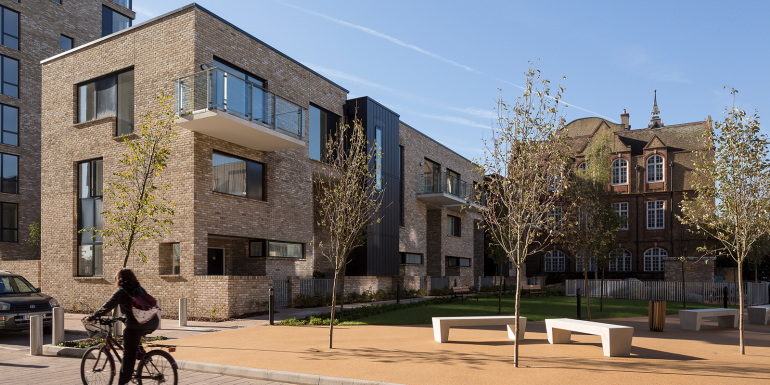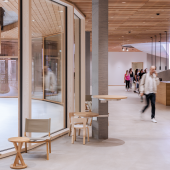Designing for longer lives

Architect Julia Park, Head of Housing Research at Levitt Bernstein and Associate Director for Homes at the Centre for Ageing Better, makes the case for accessible housing to be more than an afterthought
Despite the inescapable fact that, unless we die young, we will all grow old, we have been painfully slow to factor ageing into the way we design and construct the built environment. Even in those parts of the world where older people are revered for their wisdom and cared for by families, little thought has been given to eliminating the physical barriers that limit many peoples’ lives. 'This stubborn laziness has allowed the view that older people, and those living with a disabilities are 'better off at home', to become entrenched. Ironically, we failed there too; the concept of accessible housing is barely 30 years old.
Lifetime Homes, a 16-point standard devised to make life easier for older people, was developed by the Joseph Rowntree Foundation in the early 1990s. Though renowned and respected, as a voluntary standard it gained relatively little traction. In 1999, a watered-down version was taken into regulation through Part M, which, until then, had dealt only with public buildings. It was an important step, but it wasn’t until 2015, when the government-led Housing Standards Review concluded, that the requirements came close to where they needed to be.
And there was a catch. Setting a new precedent, two higher levels of accessibility (referred to as optional requirements) were added to the meagre baseline that, among other things, required step-free access to the main entrance (unless it was too difficult) and a small ground-floor WC (unless there were no habitable rooms on that floor). That was renamed M4(1) Category 1: Visitable dwellings and remains the default. The two optional requirements (one very similar to the full version of Lifetime Homes) and the other for wheelchair users (now M4(2) Category 2: Accessible and adaptable dwellings and M4(3) Category 3: Wheelchair user dwellings, respectively) have to be justified before being invoked. Local planning authorities must first prove need and viability, and then define the proportion of new housing that should meet each of these categories in their area.
If you are thinking it all feels a bit complicated, you’re right. Informally, local authorities were expected to require something like 30-50% of new homes to meet Category 2 and 5-10% to meet Category 3. In reality, the proportions vary from 0% to 100%. While London (which has one of the country’s youngest populations) requires 90% of new homes to meet Category 2 and the remaining 10% to meet Category 3, many local authorities still require nothing more than the baseline, partly because developers fight back if they try.
Quality of life
This is one of many reasons why the recent government consultation inviting feedback on the proposition to make Category 2 the minimum requirement is so welcome. The demographic evidence is overwhelming: by 2050, one in four people will be over 65; only 9% of existing homes provide the four main features required for even the lowest level of accessibility, and 85% of today’s homes will still exist in 30 years time.
Having ignored the implications of rising life expectancy for so long, we have a huge amount of catching up to do. Covid-19 and the climate change emergency reinforce the need to do better. The lockdowns that continue to curtail our lives have given all of us a glimpse of what, for many older and disabled people, is an everyday reality. Our homes have been tested and many haven’t scored well. Factor in age-related mobility problems with the daily challenges that arise from living in a home that fails to meet our basic daily needs, and the shortcomings intensify.
In terms of climate change, the need to reduce embodied carbon is the primary driver. Experts tell us that climate change demands that every new home we build today should last at least 200 years. During that period, we can assume that each will be home to something like 20 households and 70 individuals. Thousands of visitors, of all ages, ethnicities and faiths, will cross each threshold. All will experience bouts of illness, the vast majority will grow old, and most will use a mobility aid at some point.
The near certainty that that, over two centuries, every home will, at some point, be occupied by someone whose life would be transformed by an accessible home. But it goes beyond that; we all want to visit our friends and family in their homes too. That relies on knowing that we will be able to get through the front door, use the toilet with dignity, and feel relaxed enough to enjoy the company and the change of scene that are so important, particularly to those who live alone. The fact that a Category 2 home benefits people of all ages, while putting nobody at a disadvantage, is just as important.
Government consultation
The tone of the consultation suggested that at least some of these realities have hit home in Westminster. Three of the five options proposed making Category 2 the new minimum standard. Two of the three proposed exceptions are for scenarios where step-free access is impractical – homes above shops or small blocks of flats that can’t support the cost of installing and maintaining a lift, for example. Within reason, that is pragmatic. If, as a result of this consultation, 91% of future homes are accessible (a complete reversal of the current statistics), that would be a good outcome.
The consultation was far from perfect. Regrettably, the best outcome – a combination of Category 2 and the Nationally Described Space Standard (NDSS) – was either rejected or not considered. The guidance needs to be improved, and we must ensure that adaptable features work for all forms of construction and tenures. It would make sense to fully install the shower in ground-floor toilets when using prefabricated pods and when building for rent, for example. Implementation has been poor; and more work is needed to ensure that those who would benefit most from an accessible and adaptable home understand what such homes offer and where to find them. That argues for both local accessible housing registers and for more information.
Winning the battle for Category 2 is the immediate priority, and I am hopeful that we’re nearly there. If we learned nothing else from 2020, it is that dealing with the things we can predict will put us in a better place to deal with those that we can’t.
For more, visit gov.uk/government/consultations/raising-accessibility-standards-for-new-homes










